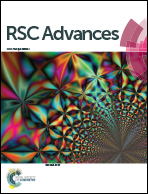A new water-soluble and colorimetric fluorescent probe for highly sensitive detection of organophosphorus pesticides†
Abstract
A new water-soluble fluorescent probe bearing 1,8-naphthalimide dye, a quaternary ammonium salt and a boronate group was developed for the detection of organophosphorus pesticides. The detection assay was composed of the probe, choline oxidase (ChOx) and acetylcholinesterase (AChE), which involved ChOx and AChE catalyze acetylcholine chloride (ACh) to produce H2O2 that increases the fluorescence of the probe. In the presence of pesticides, the activity of AChE was inhibited and the enzyme-generated H2O2 was decreased, which results in a decrease in the fluorescence of the probe. The probe displays sensitive and rapid colorimetric fluorescence towards pesticides. The fluorescence intensity was proportional to the logarithm concentration of acephate, parathion-methyl and trichlorfon over a range of 1.0 × 10−8 to 1.0 × 10−4 g L−1 (R2 = 0.9908), 1.0 × 10−9 to 1.0 × 10−5.5 g L−1 (R2 = 0.9938), 1.0 × 10−8 to 1.0 × 10−4.5 g L−1 (R2 = 0.9932), respectively. The detection limits for acephate, parathion-methyl and trichlorfon were 1.16 × 10−9, 3.36 × 10−10 and 4.72 × 10−9 g L−1 (S/N = 3), respectively. Moreover, this method has been used for the determination of practical samples with satisfactory results, which further demonstrates its value in practical applications.


 Please wait while we load your content...
Please wait while we load your content...